2021 Kawasaki KLX300SM Review - First Ride

Is Kawi's new supermoto the best new beginner bike on the market?
The 2021 Kawasaki KLX300SM might be the best new beginner motorcycle on the market. Did that get you fired up? Lemme ‘splain. It’s obvious that the new KLX300SM can be a lot of fun for riders of all levels, but there are some clear advantages of a supermoto-style motorcycle for the uninitiated.
2021 Kawasaki KLX300SM
| Engine | 17.0/20 |
| Suspension/Handling | 13.5/15 |
| Transmission/Clutch | 8.5/10 |
| Brakes | 8.25/10 |
| Instruments/Controls | 4.0/5 |
| Ergonomics/Comfort | 8.5/10 |
| Appearance/Quality | 8.25/10 |
| Desirability | 9.0/10 |
| Value | 9.0/10 |
| Overall Score | 86/100 |
First, the price isn’t bad. It’s not the cheapest, with even Kawasaki’s own Ninja and Z 400 undercutting it by a grand, but $5,999 isn’t too expensive either. Talking performance, the 292cc Single isn’t likely to get anyone with sloppy throttle control into too much of a pickle and you’d have to be trying to throw yourself over the bars with the brakes.
Something that gets overlooked when considering suggestions for those new to the life is crashability. Tip-overs happen. For new riders – or most riders really – it’s a bummer to see a big ol’ scuffed fairing due to a silly mistake. The KLX300SM will take that damage just like a dirtbike – meaning better than any street bike laden with plastic fairings. Even if you do go down you’ll probably scuff some small areas and maybe break a lever (install wrap-around handguards to lower this potential). Even if it happens, your bill for replacement parts will be nil.
And then there is maintenance. Most single-cylinder machines are easy bikes to cut one’s teeth in the art of motorcycle maintenance, but a supermoto like the KLX300SM will be about as easy as it gets when performing open-head surgery (which will need to be done every 7,600 miles) on a four-valve DOHC engine.
Don’t agree? I know you’ll let me know in the comments, but for now, let’s take a closer look at the 2021 Kawasaki KLX300SM.
More than a few choice changes
As one might expect, the two new KLXs share more than a handful of components, but there have also been quite a few changes to point these motorcycles toward their intended purposes. Kawi spent the time making the changes necessary to deliver a sporty supermoto-style 300.
2021 Kawasaki KLX300 Review – First Ride
Most obvious of course, are the 17-inch tube-type wheels front and rear with 110 and 130 section IRC Road Winner RX-01 tires. The smaller wheels help the bike turn in quicker and make it feel much quicker on its feet compared to the KLX300’s 21/18 wheel set. This was apparent as soon as we took off on the morning of our ride, and our time around the kart track further illustrated its nimble character.
A larger, 300mm front brake rotor is used to provide better braking power up front from the two-piston caliper both KLXs share. In the rear, the same 240mm disc and single piston caliper are carried over from the dual-sport model. ABS is not available, but really, on a supermoto that would just spoil the fun and drive up the cost.
While the frame is the same, the steering head angle is now 1.7-degrees steeper at 25° and trail has been reduced to 2.8 inches, making the KLX300SM effortlessly agile. Concurrently, the wheelbase has been slightly reduced by 0.2 inches. The bike feels even lighter than its 304.3-pound (claimed) curb weight while in motion, too. Again, the overall size of the bike and how slim it is should help to make the KLX300SM an intriguing choice for new riders.
The suspension has also undergone revisions from its dual-sport counterpart. Travel has dropped about an inch front and rear, to 9.1 and 8.1 inches respectively, while the spring rates have gone up considerably. The fork now uses a 10.8 n/mm spring rate while the rear has been bumped to 66.5 n/mm. This stiffens up the ride quite a bit to provide better stability for sporty riding on tarmac. It also means you’ll feel bumps coming through the seat and bars more. The fork still offers 16-way adjustable compression damping, while preload, compression (20-way), and rebound (30-way) are adjustable on the Uni-Trak linkage-type shock.
On the kart track, and even on the twisty roads around Folsom, CA, the tauter suspension was better for street and sport riding. Road imperfections weren’t swallowed up like on the dual-sport model, but less dive under hard braking was appreciated.
The seat is 1.3 inches shorter on the SM model, at 33.9, and it’s fairly comfortable for a dirtbike style one-piece seat. The lower seat height in conjunction with the overall slimness of the motorcycle helps riders touch the ground easier as well.
Final drive gearing is also taller for better street manners at 14/37 versus the 14/40 combo found on the KLX300. The gearing, counter-balancer, slimmer handlebar, and rubber footpeg inserts all help the KLX300SM feel surprisingly smooth at highway speed – moreso than the standard KLX300. The 292cc Single still puts out nice mid-range torque and will rev out fairly high before hitting the rev limiter.
The price has gone up from the standard model with these changes to $5,999, which still seems pretty reasonable for how much fun can be had on the KLX300SM. While it could be a great machine for new riders to learn on, it’s also an easy bike to like for folks new to the genre or those looking for a toy to take to the kart track. Under an experienced rider, the SM can be tossed around and pushed to its limits in a fashion that will have even the most jaded moto-journo smiling – or at least that’s what the experienced riders tell me.
Really though, we’ve said it a dozen times, a dozen different ways – going to a track will help anyone be a better rider and it allows one to test the limits of their machine in a safe environment. A supermoto is probably the easiest and cheapest way to get on track and again, will be the best off should the unfortunate lowside occur.
Don’t forget to have fun
Despite most manufacturers giving up on their street-legal supermoto models over the past couple decades, we’d like to think a resurgence of the category is just over the horizon. Kawasaki obviously does too. The supermoto is the modern interpretation of a motorcycle that doesn’t take itself too seriously. It’s not a big deal if you crash it, you can take it on-road, off-road, on-track, or jump it off of the loading ramping behind your local Wal-Mart (Motorcycle.com accepts no liability for damages to property or person during the act of supermoto-induced hooliganism, nor are we responsible for legal fees caused by having fun on two wheels).
Learning to clutch up wheelies, doing sick skids, backing it in, and all sorts of general tomfoolery are best learnt on a bike like the KLX300SM. Of course, you could just ride it around like a responsible adult too. Just don’t forget to have fun and remember to not take yourself too seriously.
2021 Kawasaki KLX300SM
+ Highs
- Agile
- Resilient to damage
- A good bike for learning (to be a hooligan)
– Sighs
- Suspension can feel a bit jarring over poorly maintained roads
- Could always be less expensive
In Gear – Street
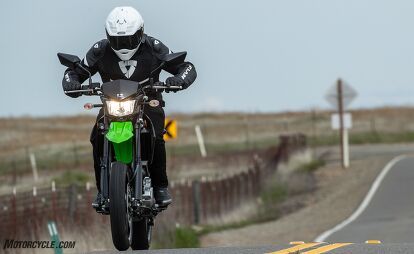
Helmet: Shoei Hornet X2 $600
- Jacket: REV’IT! Mantis $460
- Gloves: REV’IT! Sand 4 H2O $140
Boots: Dainese Axial D1 Air $530
In Gear – Track

Helmet: Shoei Hornet X2 $600
- Suit: Dainese Misano 2 D-Air $2500
- Gloves: Dainese Druid D1 Discontinued
Boots: Dainese Axial D1 Air $530
2021 Kawasaki KLX300SM Specifications | |
|---|---|
| MSRP | $5,999 |
| Engine Type | 4-stroke single, DOHC, liquid-cooled |
| Bore x Stroke | 78 mm x 61.2 mm |
| Displacement | 292cc |
| Transmission | 6-speed |
| Clutch | Return shift with wet multi-disc manual clutch |
| Starter | Electric starter |
| Final Drive | chain |
| Frame | High-tensile steel, box-section perimeter |
| Front Suspension | 43mm inverted cartridge fork with adjustable compression damping /9.1 in |
| Rear Suspension | Uni-Trak® gas-charged shock with piggyback reservoir with adjustable rebound damping and spring preload/8.1 |
| Front Brake | Single 300mm petal disc with a dual-piston caliper |
| Rear Brake | Single 240mm petal disc with single-piston caliper |
| Front Tire | 110/70-17 |
| Rear Tire | 130/70-17 |
| Tires | IRC Road Winner RX-01 |
| Rake/Trail | 25°/2.8 inches |
| Wheelbase | 56.5 inches |
| Ground Clearance | 9.3 inches |
| Seat Height | 33.9 inches |
| Fuel Capacity | 2 gallons |
| Curb Weight | 304.3 pounds (claimed) |
| Colors | Lime Green/Ebony, Oriental Blue/Ebony |
| Warranty | 12 months |
Become a Motorcycle.com insider. Get the latest motorcycle news first by subscribing to our newsletter here.

Ryan’s time in the motorcycle industry has revolved around sales and marketing prior to landing a gig at Motorcycle.com. An avid motorcyclist, interested in all shapes, sizes, and colors of motorized two-wheeled vehicles, Ryan brings a young, passionate enthusiasm to the digital pages of MO.
More by Ryan Adams



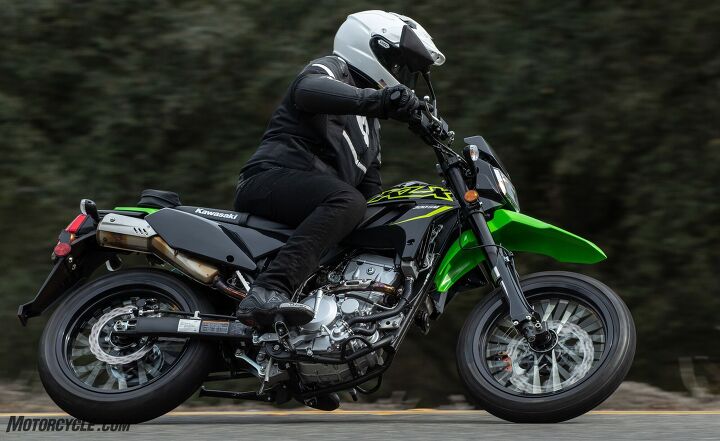










































































































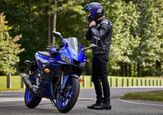
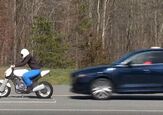
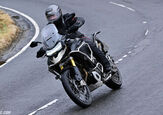
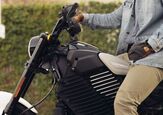
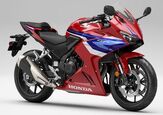
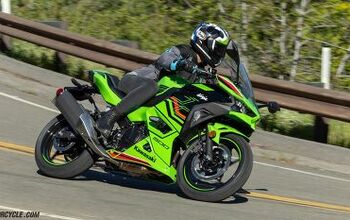
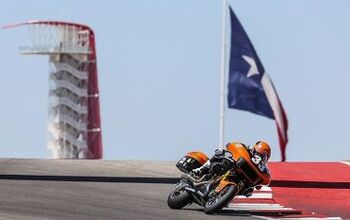
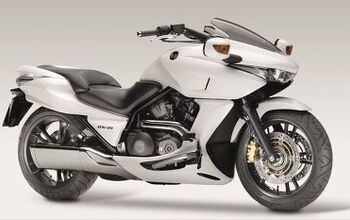
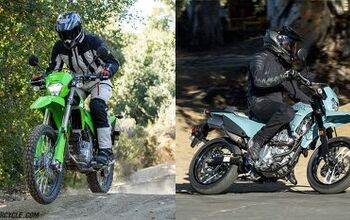
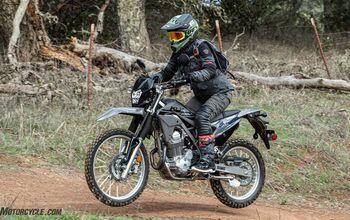
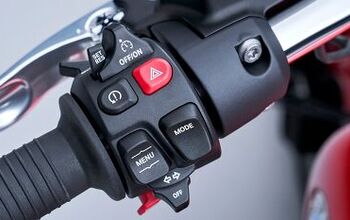
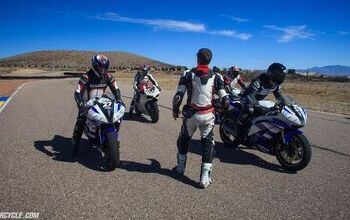
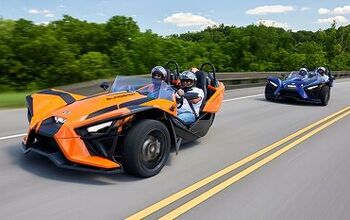
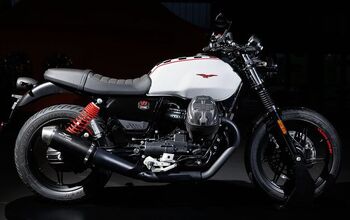
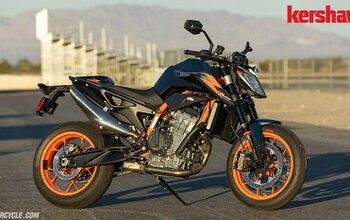
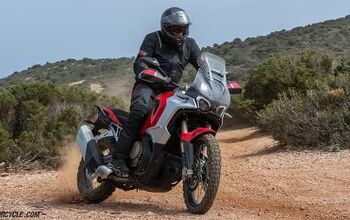
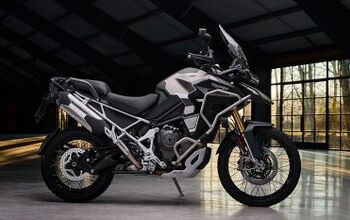



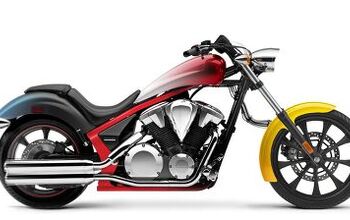
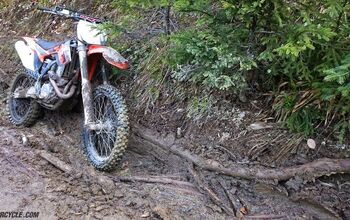
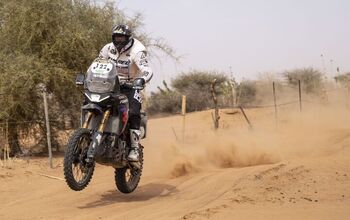
Comments
Join the conversation
It never even hit me that this bike is more expensive than the Ninja and Z 400. That's very odd considering this bike isn't much more than a single cylinder dirt bike and the other two bikes are twin cylinder street bikes.
The 7,600 mile valve adjustment interval isn't great. Maybe that's common on supermotos. I'm not too familiar with the genre.
I'm not familiar with the genre because I'm very short in the inseam - around 28". I was hoping this bike would bring supermoto to the shorties, but I guess that's not the case. I guess the Z400 is still on my radar if I decide to downsize.
Praise the motorcycle gods for giving us this bike without ABS and traction control!
A supermoto review without photos of wheelies is a B- at best. I'm sad you didn't include them, but given your EIC I completely understand.
How much do you suppose some proper radials might soften the bump response?